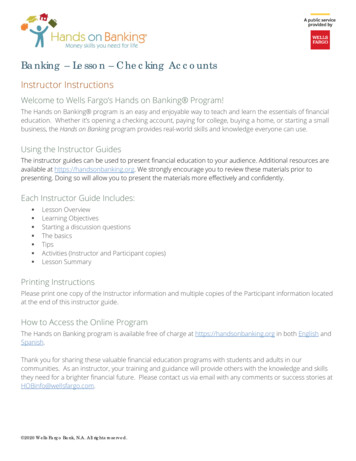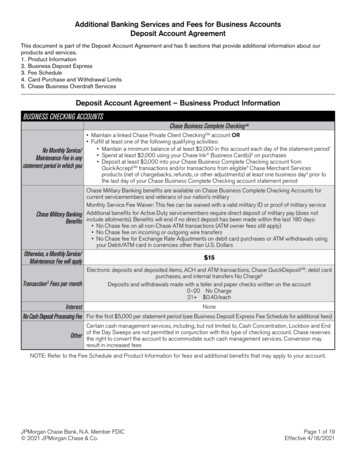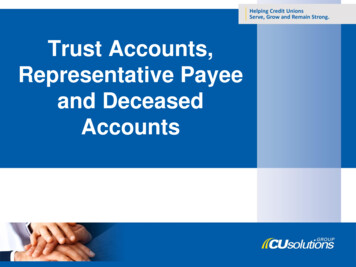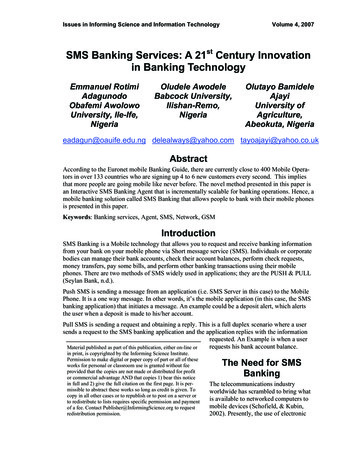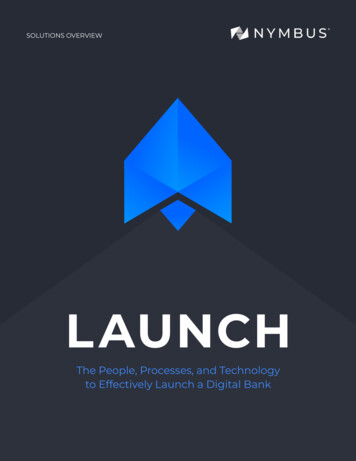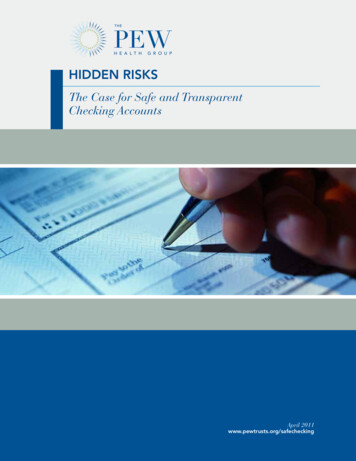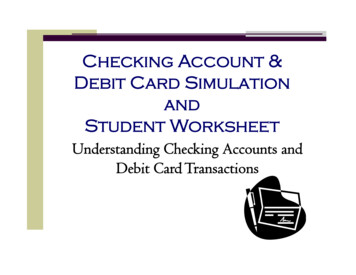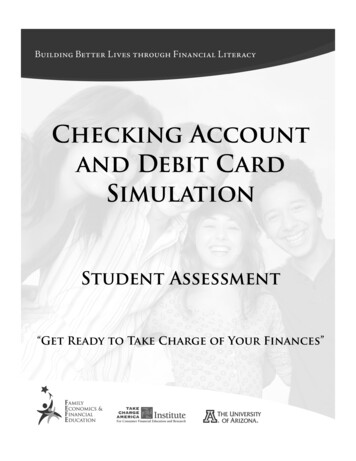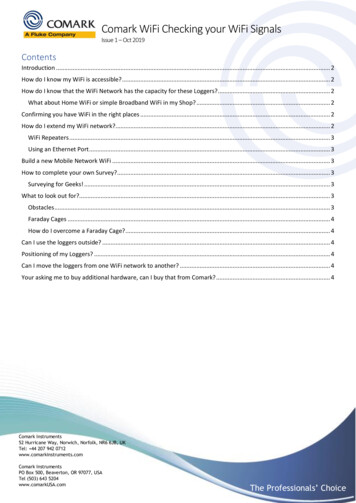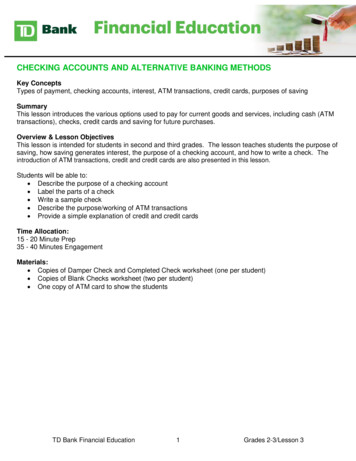
Transcription
CHECKING ACCOUNTS AND ALTERNATIVE BANKING METHODSKey ConceptsTypes of payment, checking accounts, interest, ATM transactions, credit cards, purposes of savingSummaryThis lesson introduces the various options used to pay for current goods and services, including cash (ATMtransactions), checks, credit cards and saving for future purchases.Overview & Lesson ObjectivesThis lesson is intended for students in second and third grades. The lesson teaches students the purpose ofsaving, how saving generates interest, the purpose of a checking account, and how to write a check. Theintroduction of ATM transactions, credit and credit cards are also presented in this lesson.Students will be able to: Describe the purpose of a checking account Label the parts of a check Write a sample check Describe the purpose/working of ATM transactions Provide a simple explanation of credit and credit cardsTime Allocation:15 - 20 Minute Prep35 - 40 Minutes EngagementMaterials: Copies of Damper Check and Completed Check worksheet (one per student) Copies of Blank Checks worksheet (two per student) One copy of ATM card to show the studentsTD Bank Financial Education1Grades 2-3/Lesson 3
Lesson Begins: Setting the StageBackground Builder #1: Remind students that savings accounts are a safe place to keep money. Askstudents if they know about any other types of bank accounts where people keep their money.State the Objective: tell the students what they will be able to do upon conclusion of the lesson.“At the end of this lesson you will be able to identify the parts of a check, write a check correctly, and explainwhat people use checks, ATM cards, and credit cards for.”Lesson ContinuesPeople can use a bank account to pay for goods and services like shopping at the mall or going to anamusement park. Your parents use their bank account to buy food when you go to the grocery store, pay foryour activities, such as little league registration or gymnastics.Paying by check is a safe way to pay for things because you give permission to only one company or oneperson to receive a specific amount of money.There are six parts to a check. (Explain each part to the students)DDate – The date the check is issuedAAmount – This is the amount of money to be paid to the PayeeMMaker - This is the person responsible for the amount shown above. A signature is usedto approve the money written in the Amount box.PPayee – This is the person getting the money written in the Amount Box.EEndorsement – This is a signature of the person cashing or getting the amount in theAmount Box.RRouting Number – Identifies the bank the check belongs to.Checks come in many styles and colors. Some banks will give them to you for free or you could order somereally pretty checks for an additional cost.Explain that people must write out a check correctly or the bank will not pay out the money. It is absolutelynecessary for your check to be processed correctly with all six parts of the check we just learned. RememberDAMPER?Explain that checks cannot be written for more money than a person actually has in a checking account. Thebank will charge you a fee and make you pay the money back.TD Bank Financial Education2Grades 2-3/Lesson 3
Distribute a copy of a sample check and the blank check worksheet Ask students to label the parts of a check (DAMPER) on the first blank check Next walk students through the proper steps of writing a check on the second copy, but note for themthe importance of writing a dollar amount in numbers and then writing it out in words, especially with aline extended to prohibit someone from adding his/her own name or adding a dollar amount.For example: Writing only the word “twenty” would allow someone to add “twenty thousand” but writing“twenty and 00/100 ---------” does not.Acknowledge and reinforce the efforts of each student who has completed the check correctly.Alternative banking: ATM (Automated Teller Machines) cards and credit cards Show students a copy of a debit card ATM stands for automated teller machine. A teller is the title of a person who usually handles yourbusiness at the bank. An ATM is a machine that can do that job twenty-four hours a day. Just likewith a person, you can deposit money, withdraw money, or even check an account balance at anATM. ATMs have many locations. Banks always want to keep money safe, so in order to use your ATM card you're allowed to createyour own personal identification number (PIN). You will use this number when using an ATMmachine. This is a secret, and it should never be shared with anyone or someone could take all yourmoney. You shouldn’t even lend your ATM card to someone. If it is lost or stolen, you must tell yourbank immediately so that they can do everything possible to protect your money.Credit CardsSometimes a bank will allow you to borrow money if you need it for something important. The bank allowsyou to borrow a certain amount of money to use, and then you pay back what you borrowed at a later dateyou agree on.If you don't pay the bank back in full before the deadline you agreed on, they will charge you extra money inthe form of a late fee and interest that you must also pay back. You access this loaned money often on acredit card. If the bank decides to offer you credit, you may have to pay a fee every year to use this service.Explain how a credit card works. You buy some new clothes. You have found things you like, but you don’t have enough money. You give the store your credit card. The store will scan your credit card on their machine to makesure that your bank is allowing you to have this borrowed money. When the bank has given its OK, you sign your name to authorize the bank to pay this money on yourbehalf. It’s similar to writing a check. At the end of the month, the bank will send you a statement of what you borrowed and any extramoney that you may owe. You must pay that entire amount before the deadline or the bank willcontinue to charge you extra money for the privilege of using the money it loaned you. A bank will place a limit on how much money you can borrow, so that people don’t have too manyproblems. When you have reached your limit you must pay the bank money, or it will not allow you toborrow any more money on your credit card.TD Bank Financial Education3Grades 2-3/Lesson 3
Lesson ClosesReview the DAMPER handout.An additional copy of the blank check worksheet can be distributed so the students can practice later.See the suggestion page for “Additional Engagement Opportunities / Resources”, for additional ideas.Additional Engagement Opportunities / ResourcesPair and ShareGroup students into pairs and ask each pair to exchange two or three new things learned during the day’s lesson.Call on select pairs to share with the whole class what has been learned.QuizbowlSeparate the students into two or three teams and ask questions related to the lesson.Sample Questions: How many parts to a check? Describe areas on a check the writer must complete? What is an ATM? How does a credit card work?TD Bank Financial Education4Grades 2-3/Lesson 3
Educational StandardsNational Council of Teachers of Mathematics Principles and Standards for School Mathematics, 2000 Number and Operations – (Students will) Understand numbers, ways of representing numbers,relationships among numbers, and number systems. Communication – (Students will) Organize and consolidate their mathematical thinking throughcommunication.NJ Core Curriculum Content Standards in Personal Financial Literacy 2014:Standard 9.1: 21st Century Life and Careers9.1 B. Money Management: 9.1.4.B.49.1 C. Credit and Debt Management: 9.1.4.C.1National Standards in K – 12 Personal Finance Education (from Jump tart Coalition) 2017:Spending and Saving:Standard 1, “Develop a plan for spending and saving.”Standard 2, “Develop a system for keeping and using financial records.”Standard 3, “Describe how to use different payment methods.”TD Bank Financial Education5Grades 2-3/Lesson 3
TD Bank Financial Education6Grades 2-3/Lesson 3
TD Bank Financial Education7Grades 2-3/Lesson 3
TD Bank Financial Education8Grades 2-3/Lesson 3
Debit Card SampleTD Bank Financial Education9Grades 2-3/Lesson 3
Explain that checks cannot be written for more money than a person actually has in a checking account. The bank will charge you a fee and make you pay the money back. TD Bank Financial Education 3 Grades 2-3/Lesson 3 Distribute a copy of a sample check and the blank check worksheet Ask students to label the parts of a check (DAMPER) on the first blank check Next walk students through the .
